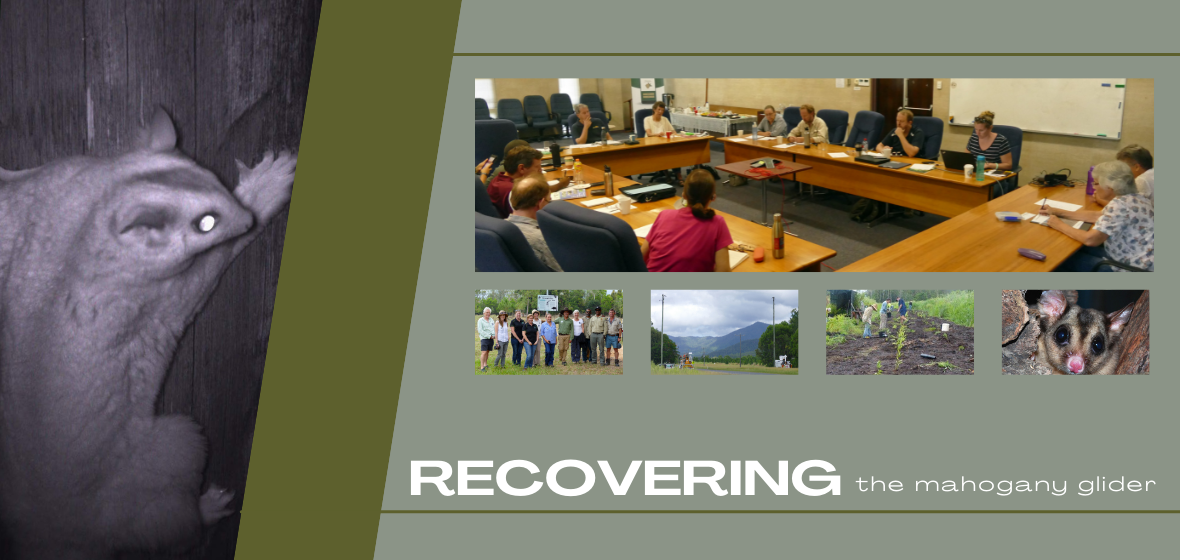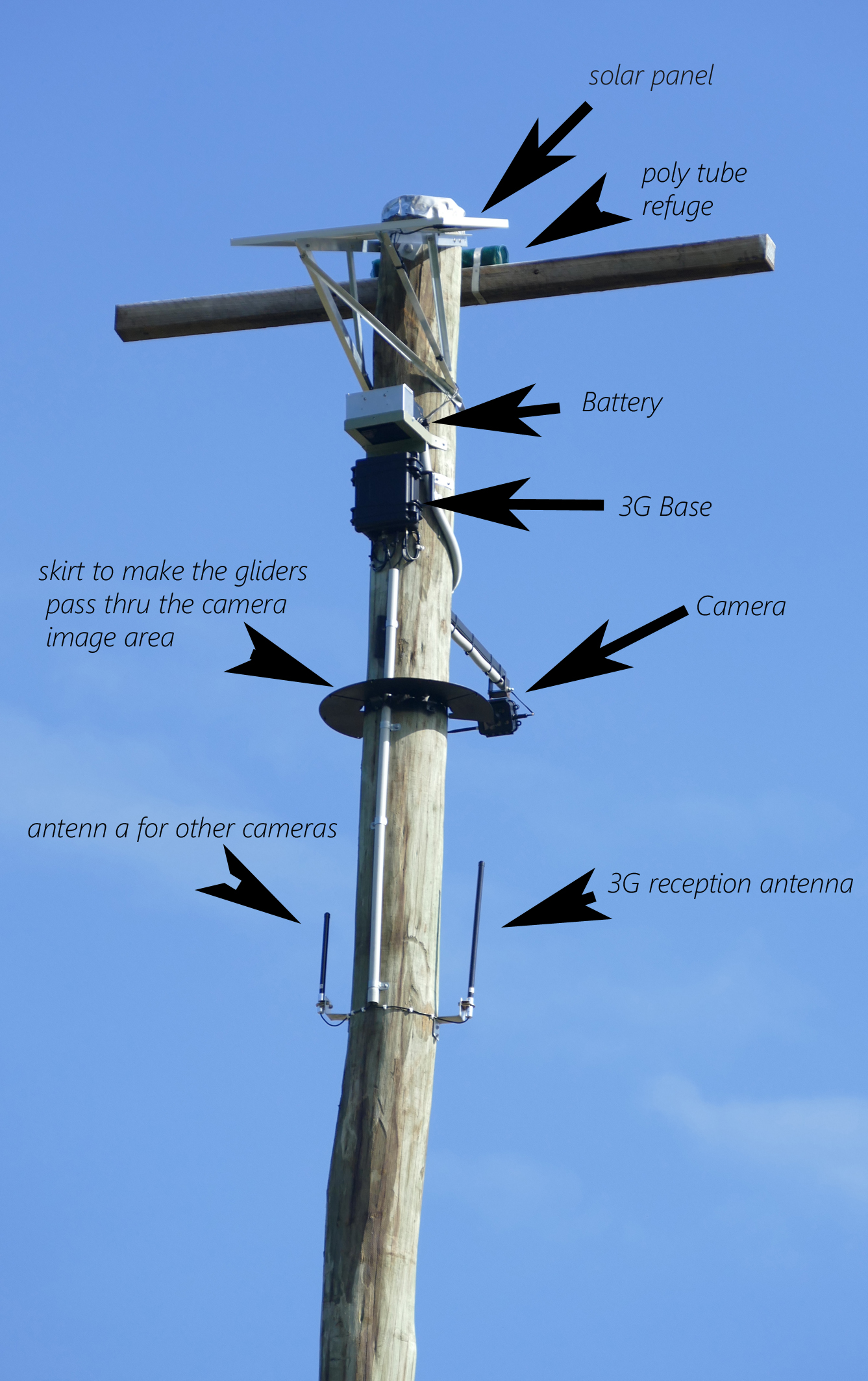
Images: Daryl Dickson
3 May 2022
Author: Daryl Dickson
It was a strange but welcome feeling the day Wildlife Queensland’s Cassowary Coast–Hinchinbrook Branch received final notification that the new National Mahogany Glider Recovery Plan had finally been legislated by the Federal Government and the plan jointly made with the Queensland Government.
A decade in the writing … ten (very) long years of determination and commitment to the mahogany glider.
The extended time frame was driven solely by the complex requirements of government – both state and federal. A decade of an ever-changing landscape of departments, changing staff, ideas and processes.
I guess we could waste a lot of time wondering how this process could possibly take so long, but over the years, it was easier for us to keep pushing forward with a clear aim and an absolute commitment to do what we could to enhance the survival of the mahogany glider (Petaurus gracilis).
The new plan is just 59 pages long, but those 59 pages reflect 10 years of collaboration, good science, research, communication and teamwork. Ten years without conflict, working together to give one of Australia’s most threatened species a plan for the future.

Clockwise from top: Wildlife Queensland representatives with the Species Commissioner for the Paddock Tree Project; Community planting projects at Cardwell; Glenbora Revegetation Project; Working with Ingham Landholders (Image: Jacqui Diggins, Terrain NRM)
Our recovery team was populated by constructive members, and time has actually helped us in some ways. It has given everyone time to develop trust, learn more about the species, and understand the mahogany glider’s landscape from so many different perspectives.
The Mahogany Glider Recovery Team made some clear decisions right at the very beginning, and these decisions shaped our process. We agreed to always aim for consensus. Our clear purpose was to write a plan that was wholly based on the best science available. The science would then inform actions that would offer a recovery path for this species. We agreed to state the facts about the measurable actions and processes that are needed for recovery, regardless of politics or opinion. We recognised that, for many reasons, some actions might be complex to negotiate and be more challenging to achieve than others.
Seize the moment!
It is worth noting that the seeds of the new recovery team were sown in late 2012. They grew out of the disaster of Severe Tropical Cyclone Yasi in 2011. Immediately after a disaster, there is a window of opportunity when most people and government agencies are catapulted into an altruistic rush to ‘mend and make good’.
There was a need to communicate constructively and work together to try to recover what had been damaged or placed at risk. It was, in our case, the first-time disaster management teams had included members that represented the natural environment. We were lucky that several of us were already working in the recovery and care of the Mahogany Glider, along with Wildlife Queensland’s Queensland Glider Network, and were included in the disaster management group. This was the catalyst we needed to establish a focused team for the recovery of the threatened mahogany glider.
Process and Priorities
Recovery for the mahogany glider isn’t just about managing the remaining habitat. Improving the fire processes and weed and rainforest incursion are all essential, but without connectivity, they will not be enough. Understanding the landscape, from many of our team member’s points of view, really matters. The opportunity to meaningfully discuss and transfer information about the needs of this species has been critical. To discuss and share ideas, to refine them, and to share our limited resources has been rewarding and has allowed us to seriously look at ways to overcome some of the challenges this species faces. It has allowed team members to plan, within their organisations and to the best of their abilities, with a clear understanding of the mahogany glider’s needs.
When the state government withdrew from chairing and coordinating the process in 2017, the team faced an uncertain future. Without the commitment of Wildlife Queensland’s Cassowary Coast–Hinchinbrook Branch (CCH) and Terrain NRM, the team may well have failed to survive. Our branch has been committed to this species since it was rediscovered in 1989, and the new recovery team was an opportunity we were not prepared to walk away from.
Suzie Smith (Wildlife Queensland’s CCH Branch Secretary) was nominated as the chairperson and Jacqui Diggins (Terrain NRM) took on team coordination to ensure this crucial work continued. The Federal Government then indicated they would support the plan through legislation when it was completed. Over the following six years, the Queensland Government returned to departmental participation, and their committed threatened species and parks staff have played a very important role in the process.
Supported by good science
Dr Steve Jackson donated his time and worked as our dedicated species specialist, providing robust scientific assessment throughout the process. Wildlife Queensland’s CCH Branch facilitated this, covering all travel costs. The recovery team has had exceptional support from Terrain NRM, which provided expertise, admin, and GIS support. The Terrain team has developed mapping portals, story map sites, and media communications that are available to all to assist in accessing and sharing information. Jacqui Diggins, from Terrain, has coordinated our team for many years and is co-author with Dr Steve Jackson on the completed plan.

Wildlife Queensland glider poles at the Kennedy Creek Crossing.
The recovery plan is written in plain English. It details the actions that must be taken to assist in the mahogany glider’s survival. It provides straightforward information to inform projects and is an essential aid to the recovery of the species. The only missing ingredients are funding and opportunity. Sadly, the situation remains that there is no guaranteed funding tied to the legislated recovery plans of almost all of Australia’s many threatened species.
Some may justifiably wonder at the purpose of a recovery plan with no funding, but even without that, it provides valuable guidance to inform the planning decisions of infrastructure providers and all levels of government. It also sits ready to guide funding – if and when it becomes available. This means that no time needs to be wasted on discovering priority actions, and no money should be wasted on ‘feel good’ projects that have no practical benefit to the survival of the species.
We will continue to assist each other as team members, make well-informed decisions, and do what we can to guide the recovery of the species where and when we can.
This decade of collaboration has seen us all work together on many projects, including:
- detailed vegetation mapping and priority corridor mapping made available for anyone making decisions in glider habitat
- a three-year camera traps project in southern mahogany glider habitat. (The Wildlife Queensland TVL project was a huge undertaking by a small team with a remarkable number of sightings. They have recorded the most southern sightings for the species!)
- the grazing for gliders project
- the completion of a Mahogany Glider Husbandry Manual
- the completion of the Glenbora–Bairds Creek Corridor Project
- ongoing Girringun fire management projects
- the ‘Bridging the Gaps’ project of camera-monitored glide poles and Glider Pole Crossings
- the ‘Joining the Dots’ project – Terrain working with landholders
- TMR, ERGON, Powerlink, CCRC, Wildlife Queensland CCH, HQ Plantations collaborations on glider poles
- the mahogany glider Story Map site
- an ongoing mahogany glider mapping portal
- ongoing Wildnet sightings base liaison
- a glider video monitoring trial (with CSIRO)
- a barbed-wire policy (HQ Plantation developed a lease requirement – no top-strand barbed wire on their estate in mahogany glider habitat areas)
- the ongoing Woodlands Project
- Terrain, JCU genetics and populations monitoring
- the Paddock Tree Project
- TSC 2020 species program
- ongoing fire and weed management programs
- den box studies
- guidelines for planners in mahogany glider habitat.
- revised Wildlife Queensland schools mahogany glider education kit completed and delivered along with school visits for mahogany glider education
- educational videos made
- revegetation and assistance to landholders.
The list, and the work, goes on …
Was it worth the effort?
Yes indeed! Sadly, with more than 1700 threatened species listed in Australia, many will have no voice.
Wildlife Queensland’s Cassowary Coast–Hinchinbrook branch made a decision long ago to be the voice, where we can, for the threatened species in our region. Being part of the recovery team for the mahogany glider has been a very important part of that commitment.
We are very proud to be part of the National Mahogany Glider Recovery Team.
How you can help
To get involved with glider conservation and volunteer to help save the mahogany glider, contact Wildlife Queensland’s Cassowary Coast–Hinchinbrook Branch or Queensland Glider Network.
Related articles and information
- Recovering the mahogany glider: a team effort
- Bridging the gap – it’s working, 2017
- Mahogany glider update Tully Branch November 2012
